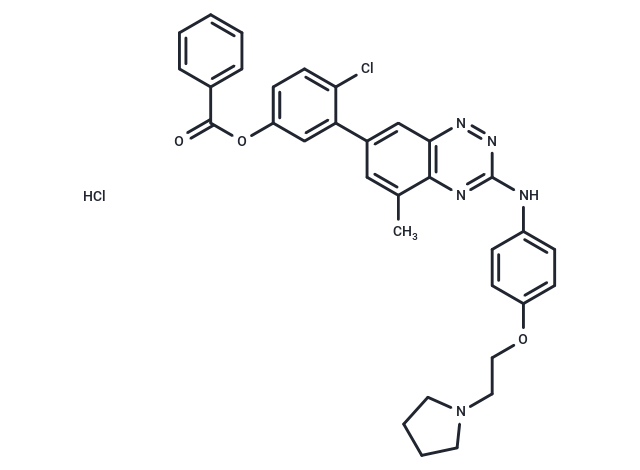Shopping Cart
- Remove All
 Your shopping cart is currently empty
Your shopping cart is currently empty

TG 100801 Hydrochloride is a prodrug to treat age-related macular degeneration. TG 100572 is a inhibitor of multi-targeted kinase(IC50s of 2, 7, 2, 16, 13, 5, 0.5, 6, 0.1, 0.4, 1, 0.2 for VEGFR1, VEGFR2, FGFR1, FGFR2, PDGFRβ, Fgr, Fyn, Hck, Lck, Lyn, Src, Yes, respectively).

| Pack Size | Price | Availability | Quantity |
|---|---|---|---|
| 25 mg | $1,520 | 1-2 weeks | |
| 50 mg | $1,980 | 1-2 weeks | |
| 100 mg | $2,500 | 1-2 weeks |
| Description | TG 100801 Hydrochloride is a prodrug to treat age-related macular degeneration. TG 100572 is a inhibitor of multi-targeted kinase(IC50s of 2, 7, 2, 16, 13, 5, 0.5, 6, 0.1, 0.4, 1, 0.2 for VEGFR1, VEGFR2, FGFR1, FGFR2, PDGFRβ, Fgr, Fyn, Hck, Lck, Lyn, Src, |
| Targets&IC50 | FGFR1:2 nM, PDGFRβ:13 nM, FGFR2:16 nM, VEGFR1:2 nM, VEGFR2:7 nM |
| In vitro | TG 100801 is readily converted to the active TG 100572 in the eye.TG 100572 is shown to inhibit hRMVEC cell proliferation(IC50 of 610±72 nM)[1]. TG 100801 is formed by derivitization of a phenolic moiety in TG100572 to yield an ester. It displays excellent balance of stability (physical and chemical) with hydrolysis rate. On its own, TG 100801 does not display meaningful anti-kinase activity, as the ester group blocks key interactions with kinase active sites, however exposure to esterases (abundant in mammalian tissues) rapidly liberates active TG100572.TG 100572 shows sub-nanomolar activity against the Src family as well as RTK such as VEGFR1 and R2, FGFR1 and R2, and PDGFRβ. vascular endothelial cell proliferation with ED50 of 610±71 nM inhibited by TG 100572 and blocks VEGF-induced phosphorylation of extracellular signal-regulated kinase[2]. |
| In vivo | A concentration of 23.4 μM (Cmax) of TG 100572 is reached in 30 min (Tmax)=0.5 h) in the choroid and the sclera. However, the levels of TG 100572 in the retina are relatively low. The half-life of TG 100572 in ocular tissues is very short; hence, the compound is administered topically minimum t.i.d. to maintain appropriate drug levels in the eye. The maximum concentration one can achieve in formulations using TG 100572 is 0.7% w/v[1]. TG 100801 nor TG100572 are detectable in plasma following topical delivery of TG 100801, and adverse safety signals (such as weight loss) are not observed even with prolonged dosing schedules. Topical TG 100801 significantly suppresses laser-induced choroidal neovascularlization in mice, and reduces fluorescein leakage from the vasculature and retinal thickening measured by optical coherence tomography in a rat model or retinal vein occlusion.In a murine model of laser-induced choroidal neovascularization (CNV), Systemic delivery of TG 100572 causes significant suppression of CNV, but with an associated weight loss suggestive of systemic toxicity[2]. |
| Molecular Weight | 616.54 |
| Formula | C33H31Cl2N5O3 |
| Cas No. | 1018069-81-2 |
| Relative Density. | 1.31g/cm3 |
| Storage | Powder: -20°C for 3 years | In solvent: -80°C for 1 year | Shipping with blue ice. | |||||||||||||||
| Solubility Information | DMSO: 5 mg/mL (8.11 mM), Sonication is recommended. | |||||||||||||||
Solution Preparation Table | ||||||||||||||||
DMSO
| ||||||||||||||||

Copyright © 2015-2024 TargetMol Chemicals Inc. All Rights Reserved.